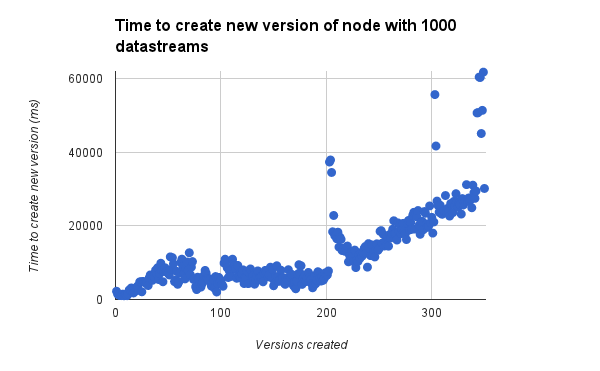OnParentVersion with many descendants
All tests involved creating a single Glossary Glossary with one or more descendant resources. Versioning had three modes: enabled on all test containers (TRUE), disabled on all test containers (FALSE), or enabled on the root container and on half of the children (HALF). onParentVersion was set to either VERSION or COPY (for non-versioned tests this has no effect). Scaling was tested by increasing the number of descendants (100, 1000) and by increasing the size of the jcr:content property on the descendant (roughly 10kb vs 1mb). Three types of descendant resources were tested: auto-named children resources with auto-generated intermediate folders (child), named children resources (named), and Glossary (DS).
After all the descendants were created and assigned the versionable mixin, when appropriate, a single new version of the root resource was created (New Version Time). Total time spent creating descendants and enabling versioning on them is recorded as Total Child Creation Time.
Time to create a new version of the root resource
The creation of a new version of the root resource was only a small portion of the overall time spent in setting up each test (~1.6% mean, 7.6% max), although there was a significant increase in the amount of time required when auto-named children were used as the descendants. Generally, using COPY mode resulted in a slower new version creation times than VERSION.
| Descendant Type | # of Descendants | Binary size | COPY (ms) | VERSION (ms) |
|---|---|---|---|---|
|
child
|
100
|
10,000 | 572 | 616 |
| 1,000,000 | 1,119 | 956 | ||
|
1000
|
10,000 | 7,227 | 7,463 | |
| 1,000,000 | 7,600 | 7,009 | ||
|
DS
|
100
|
10,000 | 172 | 75 |
| 1,000,000 | 222 | 117 | ||
|
1000
|
10,000 | 1,369 | 262 | |
| 1,000,000 | 1,925 | 288 | ||
|
named
|
100
|
10,000 | 432 | 54 |
| 1,000,000 | 438 | 99 | ||
|
1000
|
10,000 | 5,471 | 247 | |
| 1,000,000 | 4,986 | 290 |
Disk Usage
Results for disk usage were not always consistent, particularly for small batches where in some cases the size of the binary store actually decreased after a test, possibly due to background cleanup processes occurring in Modeshape. Usage was measured by using the du command on the data directory before and after running the test. Binary content was never duplicated in any of the descendant types or onParentVersion modes tested. For descendants with larger binary content the increase in disk usage for using any type of versioning over not versioning was small.
| Descendant Type | Number of descendants | Binary size | Not Versioned | COPY (ms) | VERSION (ms) |
|---|---|---|---|---|---|
|
child
|
100
|
10,000 | 2,880 | 7,259 | 7,808 |
| 1,000,000 | 132,636 | 136,706 | 136,629 | ||
|
1000
|
10,000 | 37,094 | 77,579 | 77,143 | |
| 1,000,000 | 1,325,440 | 1,368,764 | 1,370,260 | ||
|
DS
|
100
|
10,000 | 1,678 | 3,506 | 2,658 |
| 1,000,000 | 102,832 | 105,066 | 104,563 | ||
|
1000
|
10,000 | 16,443 | 33,852 | 31,444 | |
| 1,000,000 | 1,315,988 | 1,331,370 | 1,324,400 | ||
|
named
|
100
|
10,000 | 3,088 | 6,360 | 4,472 |
| 1,000,000 | 132,012 | 135,294 | 133,525 | ||
|
1000
|
10,000 | 33,792 | 63,904 | 47,862 | |
| 1,000,000 | 1,323,540 | 1,353,080 | 1,336,844 |
Full data results:
https://docs.google.com/spreadsheets/d/1SnFE-mUMEJnFUr3hXvg8UVBhnl4pq05lDTGlGR_VwYw
Multiple versions of the same container
Created a single resource with one binary and then created new versions of the resource:
Performance drop-off was considerably faster when numerous binaries (1000) were added to the root resource prior to creating many new versions of the resource.
Data
https://docs.google.com/spreadsheets/d/1QRieqQTq4LtR5r5AU0LpUPO7_C_ieBNGKU1ezqSrG5M
https://docs.google.com/spreadsheets/d/10B0ZaIrNeb0GYqQsEZszVZinXAVD1qB7xz30xuI_yws

